Concrete grade M-250
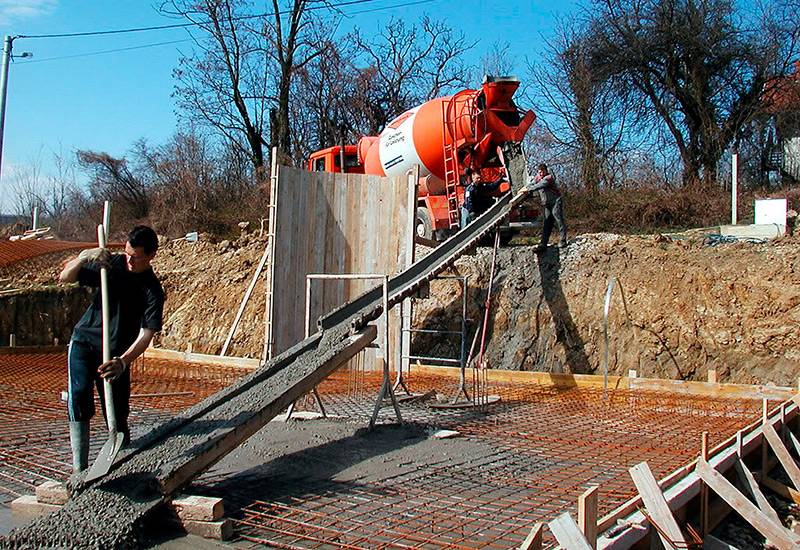
M-250 concrete is even stronger. From this cement stone, both slab, strip, and pile foundations are cast for business-class houses with a height of up to 3 floors, which have heavy slab floors in their construction. And it’s not surprising.
The concrete has a strength class B 20 and can withstand a load of 26.19 MPa. Although in fact, if the project is responsible, an experienced specialist counts only on 19 megaPascals.
And one more thing: it is already possible to cast floors from concrete of the M-250 brand, including over the basement floor. The recipe for making this solution is no more complicated than those discussed above, only the proportions and the overall yield change.
To prepare a mixture of 400 Portland cement, you will have to observe the following recipe:
- 10 kg of cement 400;
- 21 kg of river sand;
- 39 kg of medium fraction crushed stone.
And immediately the composition for working with 500 cement:
- 10 kg of cement 500;
- 26 kg of river sand;
- 45 kg of medium fraction crushed stone.
And now the same proportions, but in liters.
For cement grade 400:
- 10 liters of binder;
- 19 liters of sand;
- 34 l of crushed stone.
For cement grade 500:
- 10 l - binder;
- 24 l - sand;
- 39 l - crushed stone.
We add that the portions considered are calculated for the manufacture of 43 liters and 50 liters of the mixture, respectively.
If you are faced with the task of making exactly a cube of concrete, then with 400 cement you will have to use:
- 232 liters of cement;
- 442 liters of clean sand;
- 791 liters of crushed stone.
And with the five hundredth:
- 200 liters of cement;
- 480 liters of sand;
- 780 liters of medium-fraction crushed stone.
Note that we do not indicate the required amount of water anywhere. Since at home there is no way to determine the moisture content of the starting materials, you will have to work by eye, achieving a plastic mass, with the minimum possible amount of liquid. Remember, she is our enemy. The excess affects the strength characteristics of the finished stone.
Proportions
Buckets can be of different sizes (from 5 to 15 liters), so for accurate calculations it is most convenient to use the weight of the components. If you know the volume of the concrete mixer itself, then it is not difficult to determine the required amount of substances in the buckets. You just need to figure out the grade of ready-made concrete.
For the manufacture of one cubic meter of concrete, the following amount of materials is required:
| Components | M400 | M500 |
|---|---|---|
| Cement, kg | 338 | 292 |
| Sand, kg | 642 | 702 |
| Crushed stone, kg | 1250 | 1258 |
| Water, l | 170 | 146 |
Such a calculation is carried out if the cement is poured in stages (depending on the volume of the concrete mixer), and the process itself does not last long. It should be borne in mind that the calculations are carried out for placing concrete under normal climatic conditions. Relative air humidity ranges from 60 to 75%, and temperature ranges from +15 to +25 C.
In buckets
To calculate the amount of materials in buckets, the indicated numbers are converted to liters. The values are not completely accurate due to the unstable density of bulk materials, but they will be enough to prepare efficient concrete. The bulk density of cement is 1200 kg / m3, sand - 1440 kg / m3, and crushed stone - 1600 kg / m3.
After translation, the following values are obtained:
| Components | M400 | M500 |
|---|---|---|
| Cement, l | 281 | 243 |
| Sand, l | 445 | 487 |
| Crushed stone, l | 781 | 786 |
Now the obtained indicators are translated into buckets and it is calculated how many of them will be required to fill the concrete mixer. Most often, buckets of 10 liters are used in construction, with which the calculation will be carried out. But concrete mixers differ in size. For home use, novice builders buy devices with a volume of 70 to 250 liters. Since the mixers work in an inclined position, the amount of concrete will be less. Therefore, the calculation will be carried out for an average indicator of 55% occupancy.
The numbers opposite each ingredient indicate the number of buckets for making concrete:
| Concrete mixer volume, l | Concrete grade, M | Cement | Sand | Crushed stone | Water |
|---|---|---|---|---|---|
| 70 | 400 | 1,1 | 1,8 | 3,1 | 0,7 |
| 500 | 1 | 2 | 3,1 | 0,6 | |
| 100 | 400 | 1,5 | 2,5 | 4,3 | 1 |
| 500 | 1,3 | 2,7 | 4,3 | 0,8 | |
| 120 | 400 | 1,8 | 3 | 5 | 1,1 |
| 500 | 1,6 | 3,2 | 5 | 1 | |
| 140 | 400 | 2,2 | 3,5 | 6 | 1,3 |
| 500 | 1,8 | 3,7 | 6 | 1,1 | |
| 160 | 400 | 2,5 | 4 | 7 | 1,5 |
| 500 | 2,1 | 4,3 | 7 | 1,3 | |
| 180 | 400 | 2,8 | 4,5 | 7,7 | 1,7 |
| 500 | 2,5 | 4,8 | 7,8 | 1,5 | |
| 200 | 400 | 3 | 5 | 8,5 | 1,9 |
| 500 | 2,7 | 5,5 | 8,7 | 1,6 | |
| 220 | 400 | 3,5 | 5,3 | 9,5 | 2 |
| 500 | 3 | 6 | 9,5 | 1,8 | |
| 250 | 400 | 3,8 | 6,1 | 10,7 | 2,3 |
| 500 | 3,3 | 6,7 | 10,8 | 2 |
In everyday life, they operate according to a simplified scheme.For mixing concrete, use the proportion: 1 bucket of cement, 0.5 buckets of water, 2 buckets of sand and 4 buckets of rubble. If a plasticizer is added, then this is done already in the carefully mixed material, after which the concrete mixer is started for another couple of minutes.
For the foundation
For the construction of the foundation, depending on its type, the following cement grades are used: M200, M400 and M500. The calculation is carried out according to the same scheme as described above. The proportional ratio for the mortar is chosen 1: 3: 5 or 1: 2: 4 (cement: sand: crushed stone).
Maturation of concrete and a set of proper strength
Traditionally, all work with concrete is carried out in the warm season at positive air temperatures. In this case, the water reacts with the cement and the composition solidifies qualitatively. When pouring concrete in cold weather, water can turn into ice, which will cause the bud to lose strength and break from the inside.
Concrete “grabs” within 12 hours, hardens within the first week, after two weeks the concrete gains almost 80% of its strength, and becomes fully ready for use only after a month (subject to an ambient temperature of about 20 ° C). If you have used special types of quick-hardening concretes for pouring, the “curing” period may be shorter.
Concrete composition for the foundation
Concrete is a material consisting of:
- Astringent. Most often it is cement (Portland cement). There is also non-cement concrete, but it is not used for foundations.
- Placeholders:
- sand;
- crushed stone or gravel.
- Water.
The grade of concrete is determined by the proportions of all these components, as well as by the conditions of its hardening (setting). Optimal conditions for concrete to gain strength are created at a temperature of + 20 ° C. Under such conditions, the process is very active in the first 7 days. During this time, concrete gains about 50% strength. With such parameters, it is already possible to continue construction further. The design strength, which is taken as 100% in design, under such conditions is recruited in 28-30 days. In reality, the process continues further, but at a very low speed. The strength gained after 30 days is not taken into account anywhere - it goes "in reserve".

At what strength can the construction be continued depending on the grade of concrete
With a decrease in temperature, the setting time increases significantly (at + 15 ° C it takes about 14 days to reach 50% strength). At a temperature of + 5 ° C, the process practically stops, and under such conditions, winter concrete is already needed - with appropriate additives and / or measures to increase the temperature (wrapped, heated in a mixer, heated through the formwork or heated directly by attaching heating cables to the formwork from the inside ).
Cement
For the manufacture of concrete, various types of Portland cement are used. The most common are:
- Portland cement - begins to set no earlier than 3/4 hours and no later than 3 hours after mixing. The end of the setting is in 4-10 hours.
- Slag Portland cement - after mixing, depending on the temperatures and parameters of the solution, it begins to set in 1-6 hours, finishes in 10-12 hours.
- Pozzolanic Portland cement - hardening begins in 1-4 hours, ends in 6-12 hours.
-
Alumina cement - begins to harden in 1 hour, finishes in 8 (but not later).
Any of these types of binder can be used to prepare concrete. Only you will need to take into account the setting time of the solution - you need to lay and vibrate it before hardening.
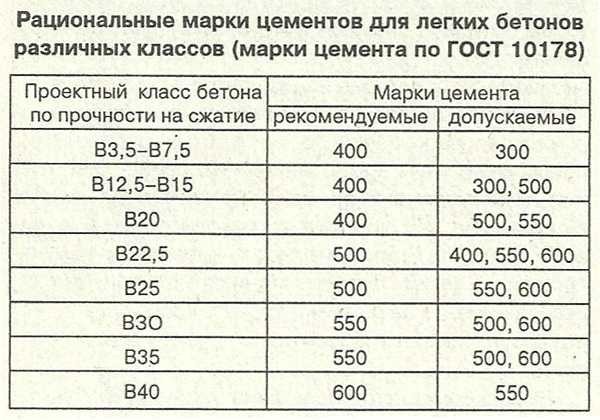
Recommended grades of cement for concrete
Placeholders
Aggregates also influence the quality of concrete. It is necessary to adhere not only to the recommended proportions, but also to quality indicators - moisture and graininess.
Sand
Depending on the size of the grains, the following types of sand are distinguished:
- large size of grains of sand 3.5-2.4 mm,
- medium - 2.5-1.9 mm,
- fine 2.0-1.5 mm;
- very small 1.6-1.1 mm);
-
thin (less than 1.2 mm).
For backfilling, mainly large and medium ones are used, less often small ones.The sand should be clean - not contain any foreign inclusions - roots, stones, plant residues, pieces of clay. Even the content of dust and silty substances is standardized - they should not be more than 5%. If you decide to "extract" the sand yourself, check the amount of pollutants.
To test 200 cc. centimeters of sand are poured into a half-liter container (can, bottle), filled with water. After a minute and a half, the water is drained, poured again and the sand is shaken. The procedure is repeated until the water is clear. If there is 185-190 cubic meters of sand left cm, it can be used - its dust content does not exceed 5%.
You also need to pay attention to the moisture content of the sand. All proportions are based on dry components. Even dry and loose sand has a moisture content of at least 1%, ordinary - 5%, wet - 10%
This must be taken into account when dosing water.
Crushed stone and gravel
Crushed stone is obtained by crushing rocks. Depending on the size of the fragments, the following fractions are distinguished:
- extra small 3-10 mm;
- small 10-12 mm;
- average 20-40 mm;
-
large 40-70 mm.
For the preparation of concrete, several fractions are used - so the distribution of crushed stone over the volume is more uniform, and the strength increases. The size of the largest fragments is normalized: it should not be more than 1/3 of the smallest size of the structure. With regard to foundations, the distance between the reinforcement rods is taken into account. SNiP also determines the amount of small crushed stone: it must be at least 1/3 of the total volume.
Gravel has approximately the same fractions and sizes, but when it is used, the water-cement ratio (water / cement or w / c) increases by 0.05 (5% more water must be poured).
Water
For the preparation and watering of concrete, potable water is used. Including the one that can be drunk after boiling. Sea water can be used with Portland and alumina cement. Any other industrial water is not suitable.
Component selection
So, the concrete mix includes four components: sand, water, crushed stone and cement. Water is a binder, due to which the mixture becomes homogeneous and acquires the required thickness.
Separately, crushed stone should be highlighted. Sometimes it is permissible to use gravel instead, but other requirements are imposed on it. The gravel must be composed of different factions. If the composition of the gravel mixture includes flat and wide stones, then their total amount should not exceed 10% of the total volume of the material. There should be no foreign additives or impurities in the gravel. All this will subsequently negatively affect the strength of the concrete foundation itself.
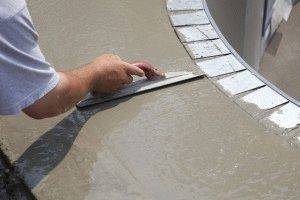
Not only for gravel, but for each component, there are a number of requirements. For example, the most ideal sand for preparing a solution is river sand. It is desirable that its particles are large. The use of sand mixed with clay is excluded. The last component leads to a complete loss of strength. The clay, which is part of the sand, and then the mixture, makes the solution greasy. Its property to swell strongly under the influence of water, and then, on the contrary, quickly shrink, leads to the fact that often cracks appear on the surface of the foundation even before it completely hardens. A large amount of clay can even contribute to the fact that the finished monolithic structure falls into pieces.
As for crushed stone, the size of the fraction should be 1-2 cm, this is the most optimal option. In addition, the material must also be clean and free of impurities.
And, perhaps, the most important component is cement. People who have never faced construction often make a common mistake, believing that if more cement is added to the solution, it will only become stronger. In fact, this is not the case. That is why the proportions established by GOST should be observed when preparing concrete. Excess cement can lead to the fact that the monolithic structure simply falls apart.
The amount of cement depends primarily on what you are going to make of the concrete. When it comes to the foundation, then the most often used cement grade is M 500.

And the last component of the solution is, of course, water. It must be clean. It is unacceptable to use water containing various impurities or particles of paint, oil, gasoline. This will lead to delamination of concrete and deterioration of its strength properties.
Concrete components
To obtain high-quality for the foundation, the proportions must be observed with maximum accuracy - the slightest deviation from the recipe can make the concrete brittle or hard, crumbly, soft or plastic. And an independent one requires even more careful control over the composition of the working mixture, since usually bulk materials and water are added to the mixture with improvised containers - in buckets, not caring too much about how much sand or cement fits into it. How to make concrete with your own hands for specific purposes and tasks will be described below, and initial knowledge should include information about the components of the concrete solution:
- Portland cement of rated grade;
- Refined or river sand;
- Additives and / or plasticizers;
- Hard aggregate - crushed stone, pebbles, gravel, construction rubble;
- Clean industrial water.
The main component of any concrete mix is cement in one form or another. It can be not only construction Portland cement, but also gypsum, alabaster, lime - substances that belong to the class of cements, but have modified characteristics that allow you to expand the functionality of the solution. All these cement additives bind the rest of the mixture components together. Choosing the brand and class of cement, first calculate the level of bearing capacity and the degree of load applied to the concrete surface, taking into account external negative factors. You can do this manually, or use a special program - an online calculator.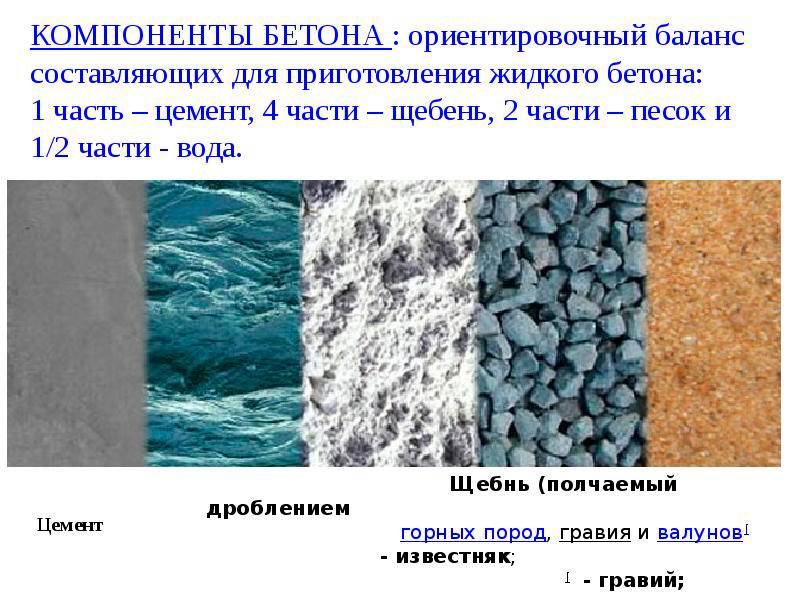 Composition and proportions of concrete
Composition and proportions of concrete
Below is a table showing the proportionality of the components in concrete for a volume of 1 m3:
| Brand | Mass fraction in kilograms | |||
| Cement M 400 | Gravel or crushed stone | Clean sand without impurities | Water, liters | |
| M 75 | 170,0 | 1053,0 | 945,0 | 210,0 |
| M 100 | 210,0 | 1080,0 | 870,0 | 210,0 |
| M 150 | 235,0 | 1080,0 | 855,0 | 210,0 |
| M 200 | 286,0 | 1080,0 | 795,0 | 210,0 |
| M 250 | 332,0 | 1080,0 | 750,0 | 215,0 |
| M 300 | 382,0 | 1080,0 | 705,0 | 220,0 |
Using a live example, you can calculate yourself that the production of concrete for 1 m3 will require the use of cement grade M 400. For more accurate results (with large volumes of components), use an online calculator:
- Class B 7.5 - 180 kg;
- Class B 10 - 200 kg;
- Class B 15 - 260 kg.
Due to the high technical and operational characteristics, both in individual and in industrial construction, Portland cement of the M 500 brand is most often used. If you prepare concrete for the foundation with your own hands from this brand, then the amount of cement given in the list above must be multiplied by 0.88 this way you can get more accurate proportions of concrete from M500 cement.
Another simple formula that allows you to find out the proportions of concrete for a foundation in buckets or in kilograms is the following: the length (L), width (B) and depth of the foundation (H) are multiplied to get the volume of hand-made concrete, observing the proportions in buckets or in kilograms ...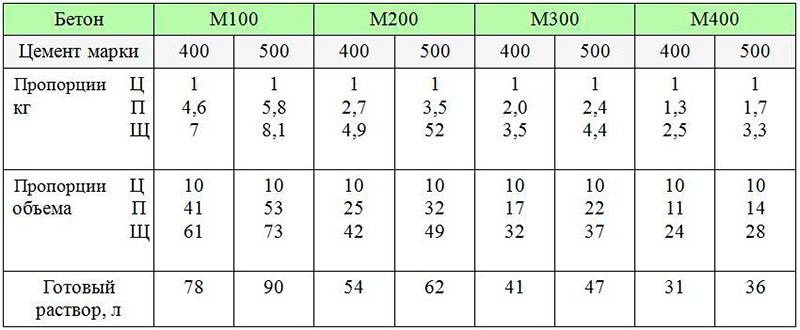 Calculation of proportions in the preparation of concrete mortar
Calculation of proportions in the preparation of concrete mortar
Load on 1 cm. Cube. denoted by numbers after the letter M. So, in order to prepare concrete at home for the foundation, it is recommended to take the M 500 brand - such cement will withstand a load of 500 kg per 1 cm3. You can also mix high-quality concrete from the M 400 grade, and to prepare a concrete solution for internal use, take the M 300 grade or less.
Recommendations for the selection of cement:
Portland cement of any brand must be dry, free-flowing, and not lumpy before being added to the mortar;
The brand of cement must be indicated on the bag;
The number written after the "D" symbol is very important - it corresponds to the percentage of impurities in the cement. For example, grade M 300-D 40 means that Portland cement contains ≤ 40% of impurities
The number 300 in the marking means that the design compressive strength of concrete (kgf / cm2) at the time of initial setting is 300 kg / cm2. Hence, we can conclude that the higher this indicator, the greater the strength of the concrete;
In individual construction, before making concrete with your own hands, the parameter after the "D" symbol can be selected in the range of 0-20. To mix the concrete mortar for a cement-sand bed under the base, as well as when carrying out preparatory work in dry soil, use a concrete mortar of class B 7.5, grade M 100, with a hard consistency of the working mixture. Crushed stone of 5–20 mm fraction and cleaned river sand are taken as a solid aggregate. Concrete with the same parameters (B 7.5; M 100), but with more plastic properties, is used for the construction of stairs, steps, fences and garden paths. You can also work with hard concrete, but in wet soil - for this, concrete of class B 10 - B12.5 grade M 150 is used.
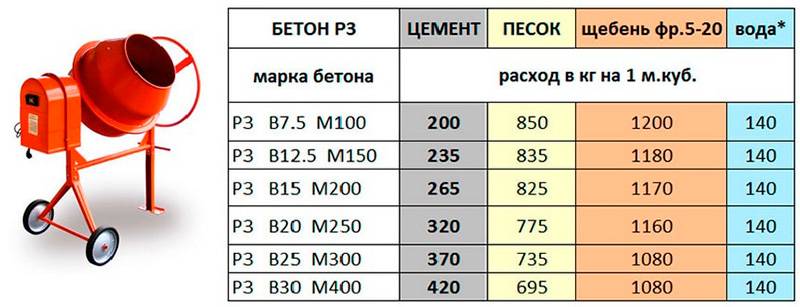 Consumption of components in the preparation of concrete
Consumption of components in the preparation of concrete
Main components
The quality of ready-mixed concrete depends not only on strict adherence to proportions, it is also related to the quality of the mixed substances and their modification. To make the concrete durable, you should adhere to the basic recommendations.
Cement
Cement affects the strength of the finished product and the rate at which it hardens.
Among all the variety of choices on the market, you should choose Portland cement. It will provide the best possible grip on all components.
The main characteristic for choosing a cement is the brand. It allows you to define the type of work for which the manufacturer is recommended to use it. The brand is designated by the letter “M” and is measured in kilograms per cubic centimeter. The strength of the dry mixture depends on it.
In order not to be mistaken in choosing cement in terms of quality and cost, you should determine in advance the type of work that is planned to be performed:

Masonry. To create a load-bearing wall, cement M400 - M500 is best suited. Other types of constructions can be made from M300 mix. If you need to create a small structure (a gazebo or a shed), then M200 cement will be enough.
Foundation. If it is necessary to lay the foundation for one-story buildings of a modest size (garage or summer kitchen), it is allowed to use M200 cement. If the building is to be residential and with several floors, then it is better to choose an M400 or M500 binder.
Blind area. To create a blind area, cement M50 or M150 is suitable
If it is necessary to repair a certain surface, then you can not pay attention to the strength at all. But with the pouring of the floors is a different story.
Here you should select a specific brand of cement. It depends on the performance of the floor.
Plaster. When preparing a solution for plaster, it is worth choosing a binder with a strength of M300 or M400.
If, during the preparation of concrete, several brands of cement have to be mixed, then the proportions of all components will have to be changed. This is done due to the fact that the content of high grade cement in the finished mortar should be less than that of low grade.
Crushed stone
To prepare a high-quality concrete mixture, it is necessary to select crushed stone with a size of 1-2 cm.
If larger stones are present, they are best used for factory work.
You also need to monitor the presence of clay inclusions in the composition and the purity of crushed stone.
Sand
This component is essential for the preparation of concrete. The best solution would be to take river or quartz sand (it contains shiny crystalline inclusions), the size of which is 1.2-3.5 mm.
You should also pay attention to the presence of clay lumps in the substance. If it is present, then the raw material is second-rate, it is not recommended to use it for the preparation of concrete.
Clay can significantly reduce the strength of the finished solution. In some situations, crushed gravel may be used instead of sand.
Water
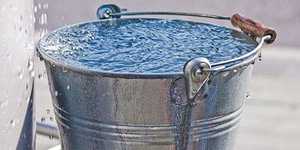
If the composition is being prepared for small-scale construction, then the type of water is not important, you can use any.
The main thing is to pay attention to its purity and the presence of oil inclusions and various chemical impurities. For domestic purposes, rain or settled water is often used.
In industrial production, purified
For domestic purposes, rain or settled water is often used. In industrial production, purified is usually used.
Excipients
It is recommended to use additional substances only when concrete is laid in special climatic conditions (low temperatures). Reinforcement (polypropylene fiber) is also often used to strengthen the finished product. It should not be added to the solution itself, but laid during its pouring.
Plasticizers
Simultaneously with their use, you should carefully monitor the amount of water that is added to the concrete mixer.
This component can significantly improve the quality of wall construction and foundation laying. You can prepare it yourself. To do this, take 100-150 ml of liquid soap in a bucket of cement, after which a similar amount of slaked lime is added. As a result, the concrete sets more evenly, and the finished surface is smoother.
Manufacturing technique
So, when the proportions are clear, you can go directly to practice. You can cook it with your own hands in two well-known ways - manual and mechanized. The first method is a simple mixing of the starting components with a shovel in a suitable container.
The method is quite laborious and requires great physical strength. The second is using a portable stirrer. This method is less labor-intensive, but requires additional financial investments - to buy a mixer.
Manual way
It is better to prepare the material using this method when the total volume of the foundation is small. For example, it can be a columnar base for a porch, terrace, barn or a small extension to the house, as well as a shallow, narrow tape of several meters around the perimeter.
After all the theoretical calculations have been carried out and it has become clear which ones are necessary in a particular case - in accordance with the type of structure, terrain conditions and load - you can proceed to the manufacturing process, which consists of the following stages:
- Preparation. It is necessary to prepare in advance not only all the necessary material (cement, sand, crushed stone, water source), but also a container suitable for mixing the components (this can be a low trough or a bath with a volume of about 100 liters) and a tool. The latter can be played by an ordinary bayonet shovel. You will also need a shovel to load the finished material into the formwork.
- Mixing of components. All measured components must be poured into a container. Then mix them with a shovel until as homogeneous as possible using the manual method.
- Adding water. In order not to get an excessive amount of it in the finished mixture during the addition of water, and not to disturb the consistency by this (simply speaking, not to spoil it with water), you need to add water in small portions during stirring until the desired consistency is reached.
Kneading with a mixer
The ratio of raw materials for the preparation of concrete is the same for both manual and mechanical methods. Preparation of a solution using a mixer is relevant when the volume of the base reaches several tens of cubes, or in all other cases when health, time or any other circumstances do not allow a private builder to interfere with the material manually.
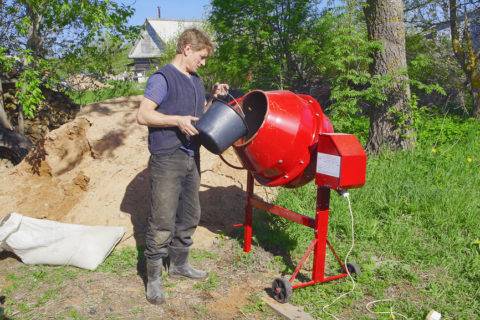 Mixer production
Mixer production
The use of such a unit makes it possible to produce material faster, with better quality and in much larger volumes.
In this case, the cooking process is reduced to the following stages:
The equipment is installed in working position. At the same time, it is necessary to take into account not so much the convenience of its loading as its unhindered unloading.
To do this, it is installed either at a special chute, through which the concrete will be delivered directly to the formwork, or directly at the formwork itself - in the case when it itself can be moved along the perimeter of the poured structure.
- A mixture of initial components is loaded, taking into account the calculated ratios. Rotation of the drum is turned on in order to mix the components in dry form.
- Water is added. The amount of water required to prepare a certain amount of concrete is best determined empirically, since sand and crushed stone may already contain a certain amount of water in their mass.
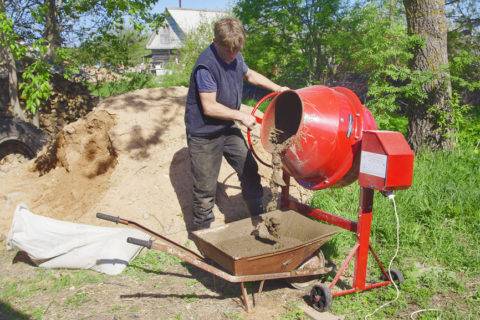 Unloading from the mixer
Unloading from the mixer
Proportions for the foundation from ASG
So, before starting construction, you need to correctly calculate the ratio of concrete components for the base. Then you need to determine what brand of material is required, based on the type of structure, soil characteristics and terrain.
After that, it is necessary to choose a convenient method for preparing the concrete mixture - by hand or by means of a suitable concrete mixer. The photos and videos in this article clearly show how to correctly calculate and prepare concrete for the foundation with your own hands.
Concrete grade for the foundation, depending on the materials of the walls and soils
Projects and calculations are not always carried out. When building summer cottages or baths, developers prefer not to spend money, and develop designs themselves. And although there are many brands of concrete, in private housing construction, mainly three are used for the foundation:
- M 200. This concrete is used when pouring the foundation for light houses - from a log or bar, panel type, light building blocks (foam blocks, gas silicate, expanded clay concrete).
- М 250. This brand of concrete for pouring the foundations of one-story buildings made of bricks and other materials of the same density, with concrete slabs overlapping.
-
M 300 brand of concrete for the foundation of a brick house, but in 2 or 3 floors.
Also, adjustments need to be made taking into account the type of soil under the foundation and the level of occurrence of groundwater. If the soils are sandy or rocky, and the water is below the freezing depth, then all recommendations remain valid. If the level of groundwater is high, and the soils are heaving, the grade of concrete is taken one step higher: the conditions are more difficult and a greater margin of safety is required.
Cement
This is the main component that is part of the concrete for the foundation, its proportions in the mixture must be kept with special care. The quality, strength, and also the brand of concrete depend on this. Usually, for the construction of foundations, Portland cement M300 or M400 is used, which is characterized by frost resistance and a quick set of strength. A higher grade is more expensive and is used in small critical structures.
To obtain high-quality concrete for the foundation, the proportion and composition of the components included in the mixture are kept exactly.
Cement has a short shelf life. When buying, you need to look at the date of manufacture of the material. It is better to take cement made no later than 1-2 months ago. If stored improperly, it has the ability to absorb moisture and set quickly. But it is not recommended to store it in a dry room for a long time. The longer the cement lays, the lower its grade becomes, and, accordingly, the consumption will be higher and the strength will be lower.

cement М400
Pouring the foundation
Pouring of concrete, as a rule, is carried out in a pit or trench prepared for this, in which a pillow is pre-laid and the foundation is reinforced, waterproofed and formwork is installed.
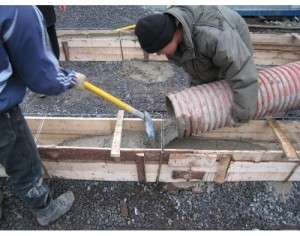
The pouring is performed at a time, pouring in several layers is allowed, while the subsequent layers must be poured even before the previous one sets.In order for the previous layer to set well with the next one, it is necessary to moisten it with water.
When the foundation is poured, its surface is leveled with a rule and left to solidify completely. To avoid the formation of air voids, it is also necessary to compact the concrete with a special vibrator.
At the end, the foundation is covered with polyethylene or roofing felt to avoid impact direct sunlight and surface cracking. The foundation will gain its strength within a month after the concrete is poured.
Finally, it must be said that the operational characteristics of the final product directly depend on the proportions and composition of the concrete mixture for the foundation, therefore it is very important to observe them correctly.
Self-priming guidelines
Before mixing the composition, it is necessary to clear and measure the area of the site, free it from construction debris, roots, etc. Then the foundation tape is marked according to the project. For work, you will need stakes, cord, tape measure, paper. The location of the outer walls of the building is determined by installing stakes in the corners of the site.
Before pouring, a trench is dug, the work is carried out by a mechanized method or manually. A cushion for the base is formed from washed sand without any admixtures of clay or silt. The sand mixture is not subject to deformation and will evenly distribute water, prevent the masonry from sagging. It is poured with a layer of at least 20 cm and rammed, you can spill the surface with water.
The next stage is the reinforcement of the foundation and the construction of the formwork. For the reinforcement cage, rods of 8-14 mm are required. The mixture is poured in the corner sections, then the rest of the voids are filled.
The speed of work is increased when using an automatic mixer. Excess air can be eliminated from the composition using a deep vibrator or manually (using a bayonet shovel, tapping with a hammer on the reinforcing cage or formwork).
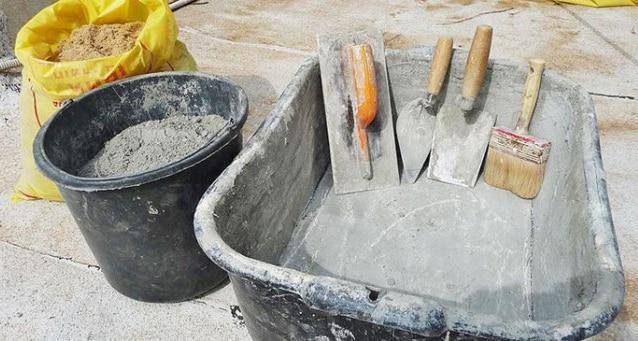
After filling the trench with the mixture, it is required to level the concrete until it hardens. It is not recommended to mix cement with sand at temperatures below + 8 ° С (unless it belongs to special frost-resistant ones). Poured in cool weather, the composition quickly collapses.
When performing the procedure in a hot summer period, the foundation should be watered for 2-3 days using a hose to prevent the foundation from drying out and cracking. No more water is required in the mortar.
for the foundation, depends on the architectural project, the place of pouring and the purpose of the building. To strengthen the composition, crushed stone of various sizes is included in it, small elements fill free cavities and enhance the mechanical stability of the base.
It is important not to allow sawdust and other impurities to enter the mixture. First, dry components (sand, gravel, cement powder) are poured into the container and thoroughly mixed until smooth
Then water is gradually introduced with constant stirring, after which pouring begins.
It is recommended to prepare the composition in 1-2 stages to prevent it from drying out. Over time, the material loses strength and other quality characteristics. The solution is not stirred with a shovel, because it will not become homogeneous. It grabs in 1 week, the mixture hardens further within 1 month.
Aggregates - crushed stone and sand
The composition of concrete is determined by those functions and characteristics of concrete that are necessary during its operation. The most common are sand and gravel. They are subject to no less stringent requirements than the quality of cement. Sometimes pebbles are used, but only if they have sharp edges, and not round ones.In the presence of broken lines, the adhesion of the aggregate to the mortar is better, as a result, the strength of the concrete is much higher.
Sand
Construction sand can be river or quarry. The river is more expensive, but it is usually cleaner and has a more uniform structure. It is best used when composing concrete. for pouring the foundation, screeds. For masonry or plastering, it is appropriate to use cheaper quarry sand.
In addition to its origin, sand is distinguished by fractions. Large or medium-sized ones are used for construction work. Small and dusty ones are not suitable. The normal size of sand grains is from 1.5 mm to 5 mm. But optimally in solution, it should be more homogeneous, with a difference in grain size of 1-2 mm.

The sand should be clean, preferably with the same grain size
The purity of the sand is also important. It definitely should not contain any extraneous organic inclusions - roots, stones, pieces of clay, etc. Even the dust content is normalized. For example, when mixing concrete for a foundation, the amount of contamination should not exceed 5%. This is determined empirically. 300 ml of sand is poured into a half-liter container, everything is filled with water. A minute later, when the grains of sand settle, the water is drained and poured again. This is repeated until it is transparent. After that, it is determined how much sand is left. If the difference is not more than 5%, the sand is clean and can be used when mixing concrete for the foundation.
For those works where the presence of clay or lime is only a plus - when laying or plastering - there is no need to take special care of the cleanliness of the sand. There should be no organic matter and stones, and the presence of clay or lime dust will only make the solution more plastic.
Crushed stone
For responsible construction - floors and foundations - crushed crushed stone is used. It has sharp edges that adhere better to the mortar, giving the structure more strength.
Crushed stone fractions are standard:
- extra small 3-10 mm;
- small 10-12 mm;
- average 20-40 mm;
-
large 40-70 mm.
Several different fractions are used simultaneously in concrete. The largest fragment should not exceed 1/3 the size of the smallest element of the structure to be filled. Let us explain. If a reinforced foundation is poured, then the structural element that is taken into account is reinforcement. Find the two closest elements. The largest stone should not be more than 1/3 of this distance. In the case of filling the blind area, the smallest size is the thickness of the concrete layer. Choose crushed stone so that it is no more than a third of its thickness.
Fine crushed stone should be about 30%. The rest of the volume is divided between medium and large in an arbitrary proportion
Pay attention to the dustiness of crushed stone. Lime dust is especially undesirable.
If there is a lot of it, the crushed stone is washed, then it is dried, and only after that it is poured into concrete.
Storing placeholders
It is clear that the construction site is not the cleanest and most equipped place, and sand and rubble are often dumped directly onto the ground. In this case, when loading, it is necessary to ensure that no earth gets into the batch. Even a small amount of it will negatively affect the quality. Therefore, it is advisable to pour aggregates onto solid areas.
It is also necessary to protect them from precipitation. In concrete formulations, the amount of constituents is given in terms of dry components. Taking into account the moisture content of components is learned with experience. If you don't have one, you have to take care of the condition and cover the sand and rubble from rain and dew.
